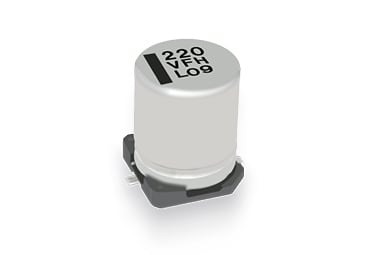Electrolytic capacitors: Still a core technology?
Follow articleHow do you feel about this article? Help us to provide better content for you.
Thank you! Your feedback has been received.
There was a problem submitting your feedback, please try again later.
What do you think of this article?
Despite the emergence of alternative capacitor technologies like hybrids, electrolytic capacitors continue to stand out as the optimal choice across various applications. Their enhanced performance, extended lifespan, and cost-effectiveness solidify their position as a top preference among designers. However, the availability of these capacitors is increasingly constrained due to certain manufacturers issuing EOL (end of life) notices, particularly for through-hole technology (THT, also known as plated through-hole, radial lead, or leaded) parts.
Aluminum electrolytic capacitors have a higher capacitance-to-volume ratio compared to ceramic capacitors, offering the advantage of compactness, a pivotal benefit in various scenarios. Commonly utilized for mitigating voltage fluctuations—such as in rectified AC smoothing, noise filtering, and audio frequency amplification—electrolytic capacitors have been the go-to choice. However, the last decade has witnessed the emergence of polymer and hybrid polymer capacitors that present distinct advantages over conventional electrolytic types. These benefits encompass an extended lifespan, elevated maximum working temperature, enhanced stability, reduced equivalent series resistance (ESR), and a safer failure mode.
Despite such advancements, many design engineers still favour straightforward electrolytics. Primarily this is due to their cost-effectiveness, particularly in applications where space constraints aren't an issue. Additionally, certain applications—for example, power supplies—rely on leaded parts, offering cost savings. Although surface mount technology (SMT) might seem dominant, especially in power supplies, the inclusion of magnetic components often necessitates through-hole mounting for mechanical stability. Consequently, PCBs must commonly accommodate both SMT and THT parts, reducing the choice between leaded or surface mount capacitors to component pricing, assuming equivalent performance.
Short video interview: "E-Caps-dead or alive? Panasonic Industry and its continued commitment to electrolytic capacitor technology"
However, concerns have arisen as some manufacturers have issued end-of-life (EOL) notices leaded electrolytic capacitors in specific case sizes. Panasonic Industry takes a different view, and distinguishes itself by considering electrolytic capacitors a core technology. The company continues to invest in research, development, and expanded manufacturing capacity. For leaded through-hole (THT/PTH) devices, Panasonic commits to supplying all case sizes and capacitance values in its portfolio for the foreseeable future.
THT Electrolytic Capacitor
Panasonic's FR and FS series exemplify high-performance leaded electrolytic capacitors. The EEU-FR series, ranging from 6.3 to 100 VDC, offers capacitance values from 4.7 to 8200µF in case sizes from Ø5x11 to Ø16x25mm. These capacitors come with a 10,000-hour lifetime, operation up to 105˚C, low ESR, and robust ripple-current capabilities. Similarly, the EEU-FS series, rated from 6.3 to 100 VDC, delivers capacitance values from 27µF to 10000µF, optimizing space and potentially reducing the required number of capacitors within the same case size.
While through-hole electrolytic capacitors still hold demand, modern designs predominantly employ surface mount (SMT) devices for their smaller form factor and ease of automation. Consequently, most research and development efforts concentrate on SMT components, an area where Panasonic leads.
Panasonic Industry's SMT FH series
A prominent trend involves enhancing capacitor lifespans to align with global sustainability movements. Panasonic, with its GREEN IMPACT initiative, pledges to achieve net-zero CO2 emissions across its operating companies by 2030. This commitment resonates with the vision for 2050, aiming to contribute to society-wide CO2 reductions by promoting energy-saving products and green energy technologies. Longer-lasting components play a pivotal role in sustainable operations, reducing the need for frequent replacements.
Specifically addressing applications, remote metering and small cell base stations necessitate components with extended lifespans due to challenging accessibility and costly downtimes. Panasonic's FH series stands out, offering the longest lifetime for surface mount electrolytic capacitors in its class. Ranging from 6.3 to 100V, these capacitors provide capacitance values from 10 to 680µF in case sizes of Ø6x7.7h to Ø10x10mm, with a 10,000-hour lifetime at 105°C—3000 hours (>40%) longer than most competitors. Competitors that match the lifetime cannot offer equivalent capacitance or temperature ratings, showcasing Panasonic's superiority. Additionally, the FH series minimizes ESR and boasts high ripple-current ratings, aligning with Panasonic's commitment to superior performance across its electrolytic capacitor range.
Thanks to substantial ongoing investments, Panasonic Industry has not only increased its electrolytic capacitor production capacity by 10% but also reduced lead times. Continual performance enhancements, particularly in lifespan, capacitance-to-size ratio, temperature ratings, and ESR, signify the company's dedication to this product sector. While some competitors exit the industry, especially concerning through-hole parts, Panasonic remains committed, ensuring the wide availability of top-performance parts. As far as Panasonic is concerned, electrolytics are undoubtedly here to stay.





Comments